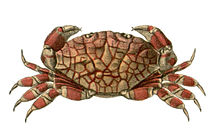| Lophozozymus | |
|---|---|
 | |
| Lophozozymus pulchellus | |
| Scientific classification | |
| Domain: | Eukaryota |
| Kingdom: | Animalia |
| Phylum: | Arthropoda |
| Class: | Malacostraca |
| Order: | Decapoda |
| Suborder: | Pleocyemata |
| Infraorder: | Brachyura |
| Family: | Xanthidae |
| Subfamily: | Zosiminae |
| Genus: | Lophozozymus A. Milne-Edwards, 1863 |
Lophozozymus is a genus of crabs in the family Xanthidae, containing the following species: [1]
- Lophozozymus anaglyptus (Heller, 1861)
- Lophozozymus bertonciniae Guinot & Richer de Forges, 1981
- Lophozozymus cristatus A. Milne-Edwards, 1867
- Lophozozymus dodone (Herbst, 1801)
- Lophozozymus edwardsi Odhner, 1925
- Lophozozymus erinnyes Ng & Chia, 1997
- Lophozozymus evestigatus Guinot, 1977
- Lophozozymus glaber Ortmann, 1843
- Lophozozymus guezei Guinot, 1977
- Lophozozymus incisus (H. Milne-Edwards, 1834)
- Lophozozymus pictor (Fabricius, 1798)
- Lophozozymus pulchellus A. Milne-Edwards, 1867
- Lophozozymus rathbuni Ward, 1942
- Lophozozymus simplex De Man, 1888
- Lophozozymus superbus (Dana, 1852)